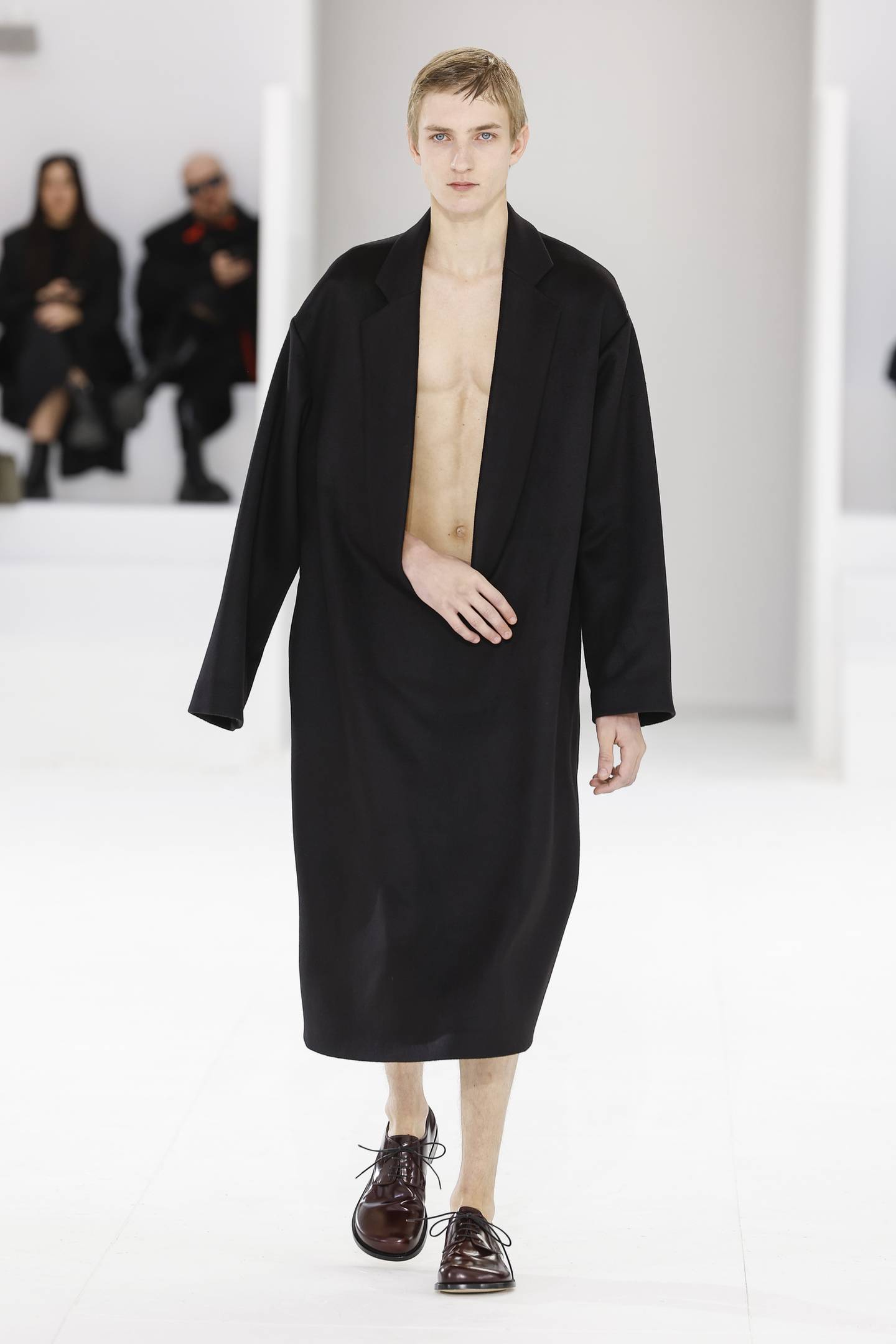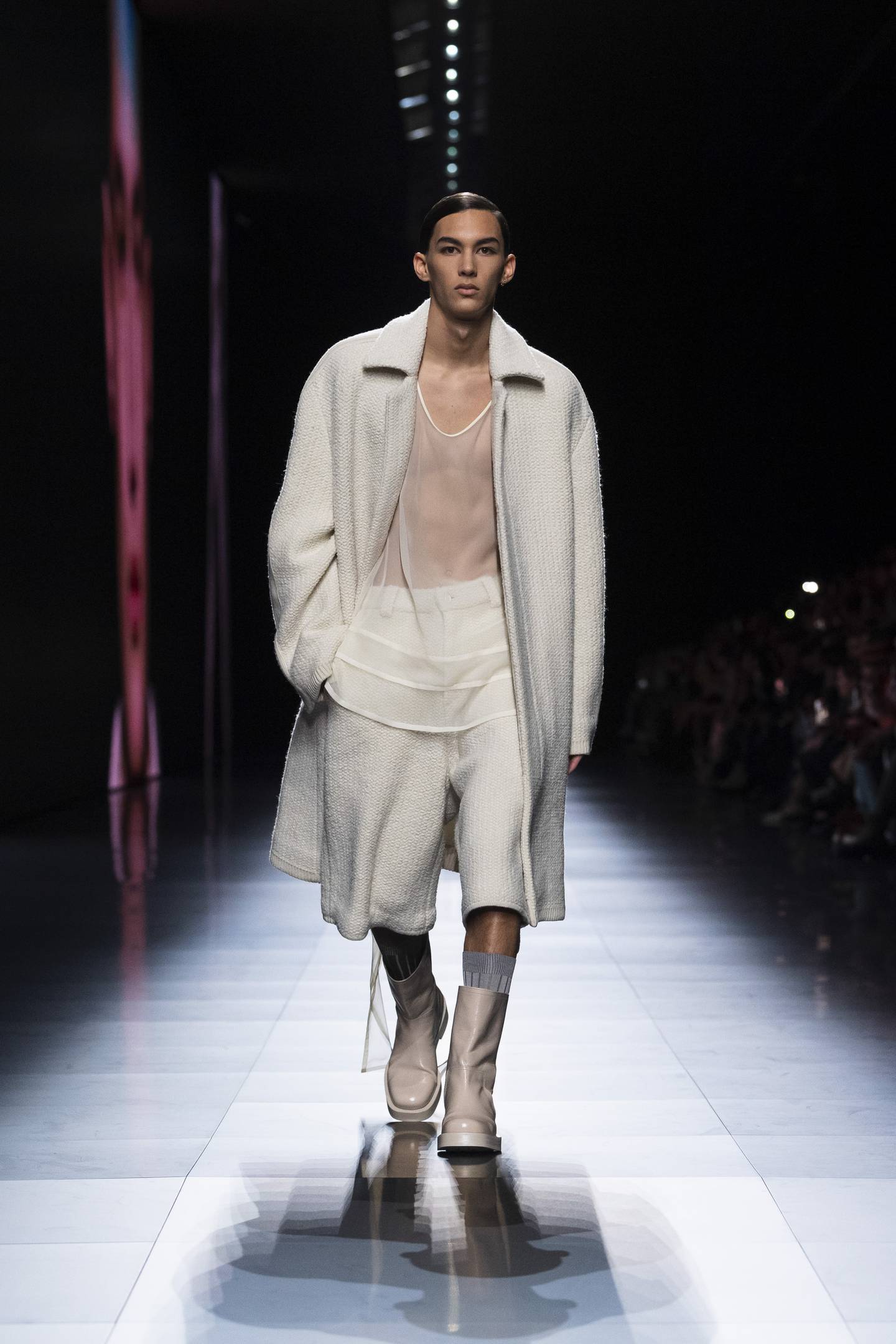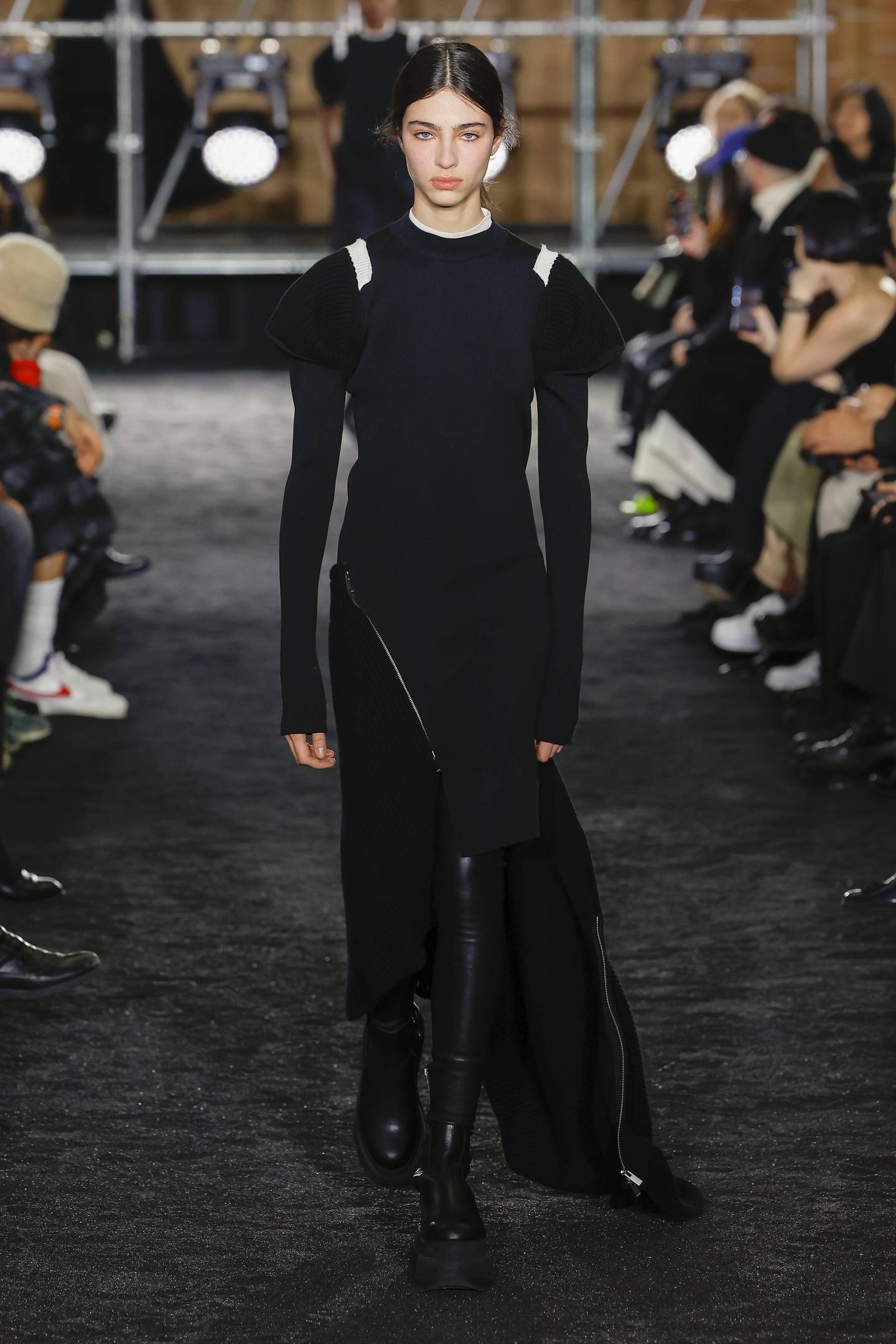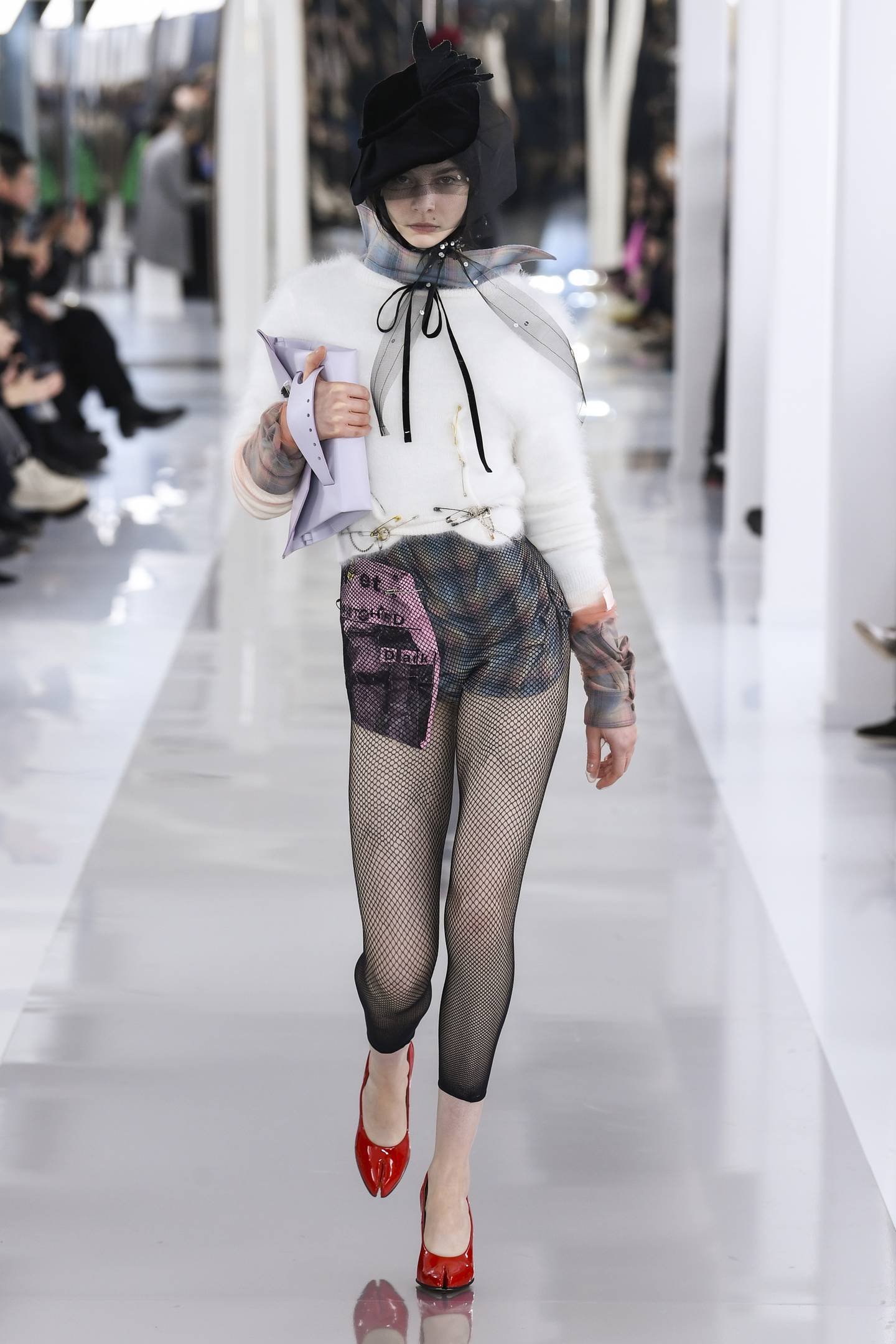
PARIS — The love affair between fashion houses and the Influencer Industrial Complex was on full display at the men’s fashion week that closed here on Sunday. So much so that the fashion sometimes felt like mere accompaniment to the “content creation.” Nowhere was this more evident than at KidSuper’s comedy show, where fans screamed but genuine fashion creation was nowhere to be seen.
And yet, fashion entertainment wasn’t what really made headlines this week, so to speak, despite the proliferation of grandiose but forgettable shows, the epitome being Louis Vuitton, which had so much going on — from the Michel and Olivier Gondry set to Rosalia singing to the colourful collection co-designed by KidSuper’s Colm Dillane — that it came across as shapeless noise. Instead, the real fashion action was focused on what really counts: la silhouette. At its best, this was a week of sculpted lines, rendered in blacks and neutrals, with no fuss.
At Loewe, Jonathan Anderson delivered a powerful show rooted in reduction: the kind that maximises not only meaning, but emotion. By focusing on the materiality of fashion making, moulding both expected and unexpected materials, including copper, into sculptural shapes that caught movement in cloth, a bit like a master painter of the early Renaissance, Anderson delivered one of his best collections in his nine-year tenure at the house. Every element fell perfectly into place, from the deliriously streamlined contours of jackets and coats to the way velvet and felts reacted differently to light.
Bringing Saint Laurent’s menswear back to Paris after years of travelling shows, designer Anthony Vaccarello finally came into his own with a collection that delivered an emotional high and a plausible idea of who and what the Saint Laurent man should be, pushing definitively past the skinny tailoring and rock leanings of the past. Everything was fluid, tall, black and morbidly elegant, with cravats and hoods aplenty, depicting Dracula charmers with a clear French touch. A captivating androgyny permeated the outing, with many of the pieces informed by Vaccarello’s womenswear: an intelligent way to animate the codes of the house. If she borrows the tuxedo from him, he can borrow the bracelets and the dramatic trench coats from her.
Constant whiffs of femininity pervaded the pearly and snowy Dior collection. Designer Kim Jones homaged Yves Saint Laurent’s brief tenure at the helm of the house immediately after Monsieur Dior suddenly died in 1957. If the clothes had fluidity and ease, the show, with a narrative plucked from T.S. Elliot’s The Waste Land (whose verses Robert Pattinson and Gwendoline Christie recited in video interspersed with close-ups of accessories) came across as unnecessary and a bit pretentious.

The strict tailoring and abundance of black this season can be read as reactionary — the world is clearly swinging right — but not at Rick Owens, whose statement this cycle was particularly black and particularly powerful: a mix of rigour and sleaze delivered through Victorian silhouettes, capes, peak shoulders, slashed denim and some mean pencil and A-line skirts oozing pure masculine power.
Matthew Williams’ Givenchy was similarly torn between the sharpness of black, strong shouldered tailoring and the roughness of urban layering, between primness and sleaze. On paper, this might have been a good way to build a contemporary identity for a historic house, but the resulting collection was slightly disconnected. Meanwhile, at Dries Van Noten, botanical prints blended with elongated elegance in black, camels and greys for a collection that felt like the nth iteration of a code — and all the better for it.
There was experimental tailoring this season, too, as some tried to find a way to draw new silhouettes and move away from the oversized shapes that have reigned supreme for so long but seem to be waning. Shoulders were massive and waists slim at LGN Louis Gabriel Nouchi, which delivered an 80s-inspired, faultlessly put together extravaganza inspired by “American Psycho.” The vision stood out; so did the casting, which included men of all ages and shapes: a welcome break from the uniformly slim and extra young guys seen elsewhere.
Rei Kawakubo experimented with lumps, bumps, zippers and extra sleeves at Comme des Garçons. It was very Comme and further proof, if any was needed, of her highly inventive, avant-garde mind. And yet Kawakubo’s idea of man as boy is wearing thin.
Interplay between the voluminous and the super narrow made the Hed Mayner collection highly engaging. Pieces seemed to be handed down from one generation to the other, in sizes that varied accordingly. It was a powerful idea that’s ripe for further exploration.
Elegance is making a comeback, in the most ornate of ways. The action hit decadent heights at Wales Bonner. For her Paris debut, designer Grace Wales Bonner was feeling lavish and intensely posh, in a maharaja kind of way, from the Place Vendôme location down to little white shells embroidered on both peacoats and track pants. As much as it exuded old world wealth and an almost colonial kind of privilege, the vision, presented on predominantly Black beauties, turned poshness into poetry, and came across as deeply touching.
Things didn’t work as well at Bode’s outing, which was both a return to the catwalk and the debut of the label’s womenswear. Based on family stories, the collection was beautifully executed and very elegant, in an old American money kind of way, but felt a bit too polished, a tad too costumey, with whiffs of Alessandro Michele goes to Connecticut.
There were brocades and bows, and the usual blacks, on slouchy poète maudit silhouettes at Yohji Yamamoto, in an nth iteration of the Japanese master’s take on badass elegance. Here, too, the goings were probably a little too costumey, but nonetheless packed with poetry.
Not everything in Paris was about creative vision. Product was front and centre in many collections. At Lemaire has always been the case, but this outing, all muted colours and welcoming volumes, felt particularly on point if offering little in the way of newness. Officine Generale delivered a perfect wardrobe of impeccable pieces with a charming Parisian flair.
The team at Homme Plissé Issey Miyake is anonymous only in the sense that their names are not communicated, because their work is far from generic. Narrow on paper, the possibilities of pleating when applied to menswear are, in fact, expansive, and this collection, with its complex geometric forms, flaps and use of intense colour mixed with black offered ample proof.
A graphic tension was the welcome addition to the usually staid, if infinitely luxurious, recipe at Hermès. This season Veronique Nichanian kept the gentleness of her man but added a metropolitan elan, and it felt timely. There was graphic collage and wonderful colour at Kolor in what was a jolly ‘n gentle take on urban flanerie, while at Sacai the goings got inventive, sci-fi even, without a hint of gimmick. Post-pandemic, Chitose Abe has cleaned up the Sacai act without forsaking the idea of the hybrid, which she herself pioneered. This outing was particularly taut: the product came to the fore in its innovative subtlety.

Elsewhere, subtlety was nowhere to be seen. Doublet’s cute but psycho galore was bonkers, as silly as it was heartwarming. It’s been a while since surreal stuff such as fish-shaped skirts felt relevant, and here somehow they did. Everything looked homemade, in a good way.
Ludovic de Saint Sernin is good at connecting with followers: he links everything to his own history and personal experiences, he strikes a chord with the me generation. His work is ego-driven and ego-centred, but in an inclusive way and that makes all the difference. This season De Saint Sernin’s brand of hormonal minimalism felt particularly minimal, to the point of looking rather basic. The collection was at a standstill, perhaps because the designer is adjusting to the dual role he now has as creative director of Ann Demeulemeester as well as his own label. But the knitted pieces, in particular the hole-y jumpers, stood out.
Casablanca’s Charaf Tajer is another crowd pleaser, filling collections with optimistic messages of love and peace. And yet, such messages are invisible in the clothes. This season’s stress on 70s pimp tailoring had very little to do with the partying youth of Syria to whom the collection was dedicated, so much so that Tajer’s speech at the beginning of the show felt unnecessary.
Meanwhile Amiri is fast building a considerable following. The hype level is high, but there is honesty to Mike Amiri’s work, if not much design originality, and the product certainly looks tempting. On the flipside, the product looked a little soulless at Kenzo, where Nigo’s interpretation of the East meets West ethos continues to lack charm.
In just five years, Marine Serre has built a distinctive identity and a strong following. But despite the unquestionable appeal of the recipe, it is essentially unoriginal: Serre’s post apocalyptic world is rooted in a specific chapter in the work of Jean Paul Gaultier. This season, there were also heavy debts to Martin Margiela and Xuly-Bet.
Mixing a Kurdish sense of decoration with sharp tailoring and subcultural torsions, not an ounce of hype needed, Dilan Lurr has grown Namacheko into a quiet fashion force. His take on tailoring is diligent, but also twisted.

In a season of new formality, tailoring and the silhouette, the co-ed Maison Margiela show that ended the week felt like a fitting conclusion. As much as it was laden with a feeling of lunatic in the attic and known Galliano tricks (the veils, the 50s, the bonkers ladylike on both him and her), it was also a thrilling detour around construction and deconstruction, and layering of meaning and seduction. The silhouette here was built on piling up and brutally peeling down: opposite forces that capture the contrasts of this strange moment, in fashion and beyond.



